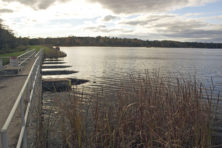Co-director Presents Lake Study Progress Report
- Share
- Tweet
- Pin
- Share
The co-director of the International Upper Great Lakes Study board presented a “progress report” to about 100 attendees at the Third Avenue Playhouse in Sturgeon Bay July 18.
Eugene Stakhiv told the crowd that there are engineering options that could bring Lake Michigan and Huron water levels up, but at tremendous cost and with disconcerting side effects.
“There are no win-win solutions,” Stakhiv said.
Various engineering projects could be taken along Michigan’s St. Clair River to raise levels in Lakes Michigan and Huron (geologically considered a single body of water) up to 25 cm. Water flows out of Lake Huron into the St. Clair River and into Lake St. Clair, and eventually to Lake Erie.
Options include the construction of 30-feet wiers that would act as water speed bumps to slow the water flow through the St. Clair River, underwater wind turbines, or even inflatable weirs. None of them are cheap – the report estimates a cost of at least $205 million – and all come with drawbacks for aquatic species like the Lake Sturgeon that spawns in the river, as well as for downstream communities.
“The people downstream, especially those on Lake St. Clair, would vehemently oppose most of those changes,” Stakhiv said.
Power-generating turbines could raise lake levels as much as 20 cm, but would only generate 15 mw of power and require 150 turbines to make an impact. “Try to imagine what that would do to the [Lake] Sturgeon,” Stakhiv said.
But there are bigger questions Stakhiv asked as well.
“Who is going to manage these projects?” he asked. “Who will pay for them? How long will it take? How many permits and how much money will it take?”
The last major engineering project completed on the Great Lakes was the Saint Lawrence Seaway in 1958. Negotiations between the United States and Canada and joint construction by the two countries took 50 years to complete. Taking on a similar project today is daunting, Stakhiv said.
“Back then we were in a growth stage as a country, but we’re a more stable society now,” he said. “We don’t need the major water-based projects for energy production and industry.”
The thrust of Stakhiv’s presentation was, in a word, uncertainty. The report predicts more precipitation and intense storms over the next three decades in the Great Lakes basin, but also more extreme droughts and more evaporation due to high temperatures and reduced winter ice cover on the lakes.
It’s unclear, Stakhiv said, if lake levels will rebound, or what impact climate change will have on the lakes. He also cautioned against embarking on a costly, possibly detrimental response to what is, in a historical context, a short period of low water levels.
“There have been profound shifts in lake levels throughout history,” Stakhiv said. “Over the past 2,000 years, we’ve seen 150-year periods of high or low levels that dwarf the 10 and 20-year cycles we’re seeing today.”
But he also warned that we can’t “operate under the faulty assumption that the future will replicate the historic record.”
After his presentation Stakhiv responded to several questions from the audience, including suggestions from listeners that curbing other water diversions be considered.
• On reversing the flow of the Chicago River
Reversing the flow of the Chicago River to its natural direction would raise lake levels, Stakhiv said, but it would also send millions of gallons of polluted water into Lake Michigan. To clean the water would require a waste treatment plant with a cost of $3 to 4 billion.
• On curbing municipal and industrial groundwater draws from Lake Michigan and the Great Lakes Basin
Stakhiv said municipal and industrial withdrawals account for less than 1 percent of the lakes’ volume and that most of that water is returned to the basin after use. He also said that 30 times more water is brought into the basin than taken out, in the form of bottled water, soda, beer, and other products.
The IUGLS study will be submitted for scientific peer review in December.

